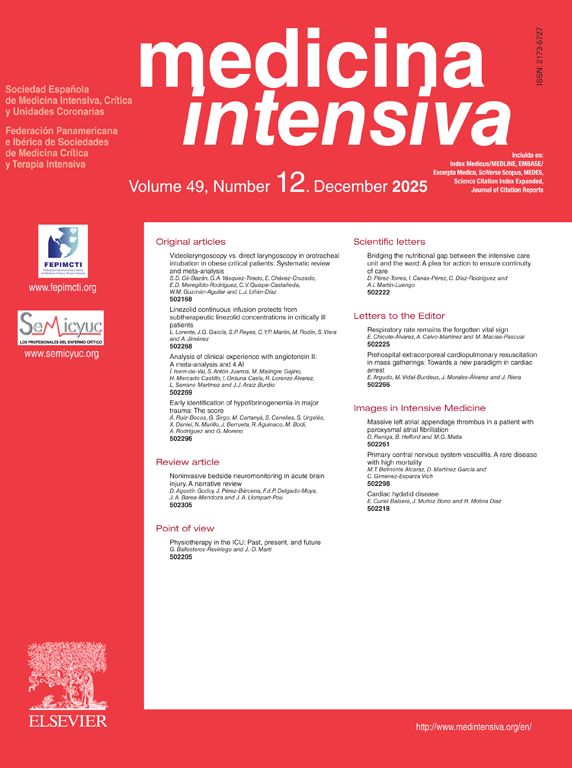In the ongoing quest to understand and manage acute respiratory distress syndrome (ARDS), a new post-hoc analysis of the Mechanical Power Day study by Fajardo-Campoverdi et al.1 shows that, of all the ventilatory parameters and their respective formulas, elastic static power best correlates with ARDS severity, and may be a key predictor of its development. This finding challenges the traditional approaches to invasive mechanical ventilation (IMV) and raises the possibility of using the measurement of only part of the mechanical power formula as a routine clinical tool in Intensive Care Units.
On considering the article by Gattinoni et al. published in 2016,2 in which they first spoke of mechanical power as the IMV parameter that encompasses all those parameters previously proposed as being harmful to the lung, it can be seen that their formula is derived from the equation of motion. The equation of motion refers to the fact that the total pressure we apply to the respiratory system is the sum of the elastic pressure (Pel), the resistive pressure (Pres), and the positive end-expiratory pressure (PEEP). Elastic pressure is the pressure required to distend the lung parenchyma and rib cage; Pres is the pressure required to overcome airway resistance; and PEEP is the basal residual pressure maintained in the respiratory system at the end of expiration.2 In turn, within Pel, there are two components: dynamic Pel, which corresponds to the distension produced by the pressure in the lung parenchyma with the change in volume with respect to its initial size in each breath; and static Pel, i.e., the change in volume with respect to the initial size produced by PEEP. This leads us to break down the mechanical power formula into four different formulas: resistive power, total elastic power, elastic dynamic power and elastic static power.
Some authors argue that Pres does not cause direct damage to the lung parenchyma and propose excluding it from the mechanical power formula.3 Others suggest that lung damage is mainly related to dynamic volume change, with the static component having a lesser effect.4 However, other studies have emphasized the fundamental role of PEEP in the energy delivered to the lung and that high levels of PEEP do not always improve pulmonary mechanics or hypoxemia and, in some cases, may cause alveolar overdistension and increase the risk of ventilator-induced lung injury (VILI).5
The study published by Fajardo-Campoverdi et al. suggests that elastic static power is the formula most closely correlated with ARDS severity. This formula includes PEEP but excludes plateau pressure and driving pressure, thus ignoring the effect of PEEP on respiratory mechanics. In this formula, PEEP only multiplies. The higher the PEEP, the more energy is delivered to the lungs. However, more energy does not necessarily mean more severe disease or greater lung damage. Other studies have shown that adjusting mechanical power to ideal weight or compliance improves the prognosis of ARDS patients.6 In fact, in 2024, Xie et al. observed that the parameter most closely related to mortality was total elastic power adjusted for compliance.7
In recent years, studies similar to that of Fajardo Campoverdi et al. have been performed. They suggest that the formulas most closely related to the severity of ARDS are those that take into account the elastic component. While some propose elastic dynamic power as the best marker,8 others emphasize total elastic power, which includes the effect of PEEP.7,9,10 No study to date has prioritized elastic static power as a unique predictor. However, Xie et al. found that PEEP, per se, is also a factor strongly associated with ARDS severity.9
We must bear in mind that PEEP is a physician-adjusted parameter. In this regard, physicians tend to prescribe higher values in more severe ARDS patients, as suggested by the guidelines and the old FiO2-PEEP tables. Thus, is elastic static power a direct marker of ARDS severity, or does it simply reflect a non-causal relationship due to clinical practice? More importantly, is this parameter a useful tool to guide IMV management or merely an indirect indicator?
Although elastic static power emerges as a possible marker related to ARDS severity, future prospective and randomized studies comparing the impact of different components of mechanical power on the clinical outcomes should be performed.
Declaration of Generative AI and AI-assisted technologies in the writing processDuring the preparation of this paper, the author(s) used ChatGPT to summarize and improve the clarity of the text, thereby facilitating its comprehension. Following the use of this tool/service, the author(s) conducted a thorough review and edited the text, assuming full responsibility for the publication’s content.
Financial supportThis study did not receive funding from any public, private or institutional source.





